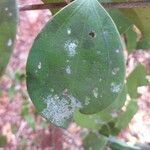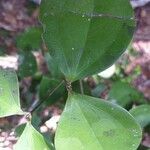Small, erect, much-branched tree or shrub, 2–10 m. high, with a spreading rounded crown and neither spines nor tendrils.. Branchlets pale, ashy or straw-coloured, ± swollen at the nodes and with persistent petiole-bases; young branchlets subquadrangular; lenticels few and inconspicuous.. Leaves subsessile, usually rather congested and very variable in size and shape even on the same branchlet, coriaceous or subcoriaceous, broadly ovate, ovate-lanceolate, elliptic or oblong-elliptic, 2–9 cm. long, 1–6 cm. wide, rounded, acute or acuminate at the apex, rounded, cuneate or rarely subcordate at the base, usually shiny above, 3-nerved from the base and often with 1, rarely 2, submarginal nerves on each side; tertiary nerves usually very prominent on both surfaces.. Cymes usually compound, axillary and terminal, subsessile or pedunculate; peduncle 0.2–2 cm. long.. Flowers fragrant, sometimes cleistogamous, 4–6-merous, sessile or subsessile, often densely clustered, 2–2.5 mm. long and 4 mm. in diameter when open.. Calyx-lobes broadly ovate-orbicular, ciliate.. Corolla yellow or cream-coloured, subrotate; lobes ovate-deltoid, about 1.5 mm. long, subequal to or longer than the tube, acute or subacute, pubescent within (particularly at the base), more rarely glabrous, usually glabrous outside.. Stamens inserted in the sinuses of the corolla-lobes, just exserted.. Ovary globose; style short.. Fruit globose or ovoid, 8–14 mm. long, 6–11 mm. broad, with a thin rind, red or brown.. Seeds usually like coffee-beans with an elongated ridged groove down one side, ellipsoid or elongate-ellipsoid, 9–10 mm. long, 6 mm. broad.
Tree or shrub, 1.5-18.0 m high, bark yellowish to brown. Leaves decussate, glabrous, up to 3 mm long, shiny above, elliptic, oblong or ovate, apex acuminate, margins entire; petioles short. Inflorescence terminal or axillary; pedicels short; bracts small. Flowers 5-merous, greenish creamy. Calyx green, connate at base, apex obtuse, 4-lobed. Corolla 4-lobed, cream-coloured, inner surface pilose, outer surface glabrous; tube short. Stamens 4, exserted on corolla tube; anthers elliptic; filaments short. Ovary with up to 12 ovules; style straight, stigma capitate. Flowering time Oct.-Dec. Fruit 1-seeded, ellipsoid, yellow-orange, 0.8 x 1.5 mm in diam. Seeds pale brown, ellipsoid.
Leaves petiole short, glabrous 1–3 mm. long; lamina pale to dark to dark green and shining above, less shining and paler beneath, coriaceous, very variable in shape and size even in a single branchlet, elliptic, oblong, narrowly elliptic, or ovate, (1·2)1·5–3(3·5) x as long wide, (1·5)2–6(10) x (0·6)1–3(6) cm., rounded to acuminate at the apex, cuneate, rounded, or sometimes on main axis subcordate (and then comparatively wider); glabrous on both sides; one pair of secondary veins from or from above the base curved along the margin and one rarely two faint submarginal pairs; tertiary venation reticulate, prominent on both sides, especially in thick leaves.
Corolla in the mature bud 2·3–3 x as long as the calyx, 2·8–4 mm. long, greenish–yellow, creamy, or white, subrotate and 4–5 mm. in diam. when open, glabrous outside, inside pilose or villose at the base of the lobes or sometimes entirely glabrous; tube short, 0·7–1·2 x as long as the calyx, 0·8–1·5 mm. wide; lobes thick, triangular to ovate, 1·7–2·5 x as long as the tube, 1·7–2 x as long as wide, 2–2·5 x 1–1·6 mm., acute, spreading.
A shrub or small tree. It has many branches. It grows 3-6 m tall. The leaves are glossy and opposite. It has 3 prominent veins. The leaves are oval. The flowers are pink and in groups in the axils of leaves. The fruit are 2 cm long. They are green and turn red when ripe.
Tree, 3-16 m high. Leaves usually acute to subacute, distinctly 3-nerved from base, up to 65 mm long. Inflorescence lateral. Flowers 5-merous. Fruit small, 12 mm in diameter. Seeds deeply grooved. Flowers greenish yellow, orange, yellow or cream.
Pistil glabrous, 1·6–2·2(3) mm. long; ovary globose, depressed–globose, or sometimes ovoid, 0·8–1·2(1·5) x 0·9–1·4 mm., rounded or sometimes acuminate at the apex, 2–celled; style 0·7–1 mm. long; stigma capitate.
Sepals pale green, connate at the base, broadly orbicular or nearly so, 1–1·4 x 1–1·4 mm., rounded or obtuse at the apex, minutely ciliate, glabrous on both sides, without colleters.
Seed pale brown, ellipsoid, not flattened, 0·8 x 0·5 x 0·5–1·2 x 0·7 x 0·7 cm., glabrous, smooth, with a deep closed groove at one side (like coffee–bean), very minutely fovelate.
Branches pale grey or pale brown, sometimes shallowly fissured, not lenticellate; branchlets conspicuously sulcate when dry, glabrous.
Inflorescence axillary and sometimes also terminal, much shorter than the leaves, 1 x 1–2 x 2 cm., congested, few– or many–flowered.
Bracts small, upper sepal–like, lower larger, sparsely pubescent to glabrous beneath, often with colleters in the axils.
Stamens just exserted; inserted at the mouth of the corolla tube; anthers elliptic, 0·8–1 x 0·5–0·8 mm., glabrous.
Peduncle often very short, sparsely pubescent to glabrous like the branches and pedicels.
Fruit yellow, orange, or red, ellipsoid, 1 x 0·8–2 x 1·5 cm., one–seeded. Wall thin.
Trunk 40–50 cm. in diam. (more or less); bark pale grey or pale brown, rough.
Shrub or small tree, 2–10(20) m. high with spreading rounded crown.
Flowers fragrant, 5–merous, sessile or subsessile.
In each cell 8–12 ovules.



